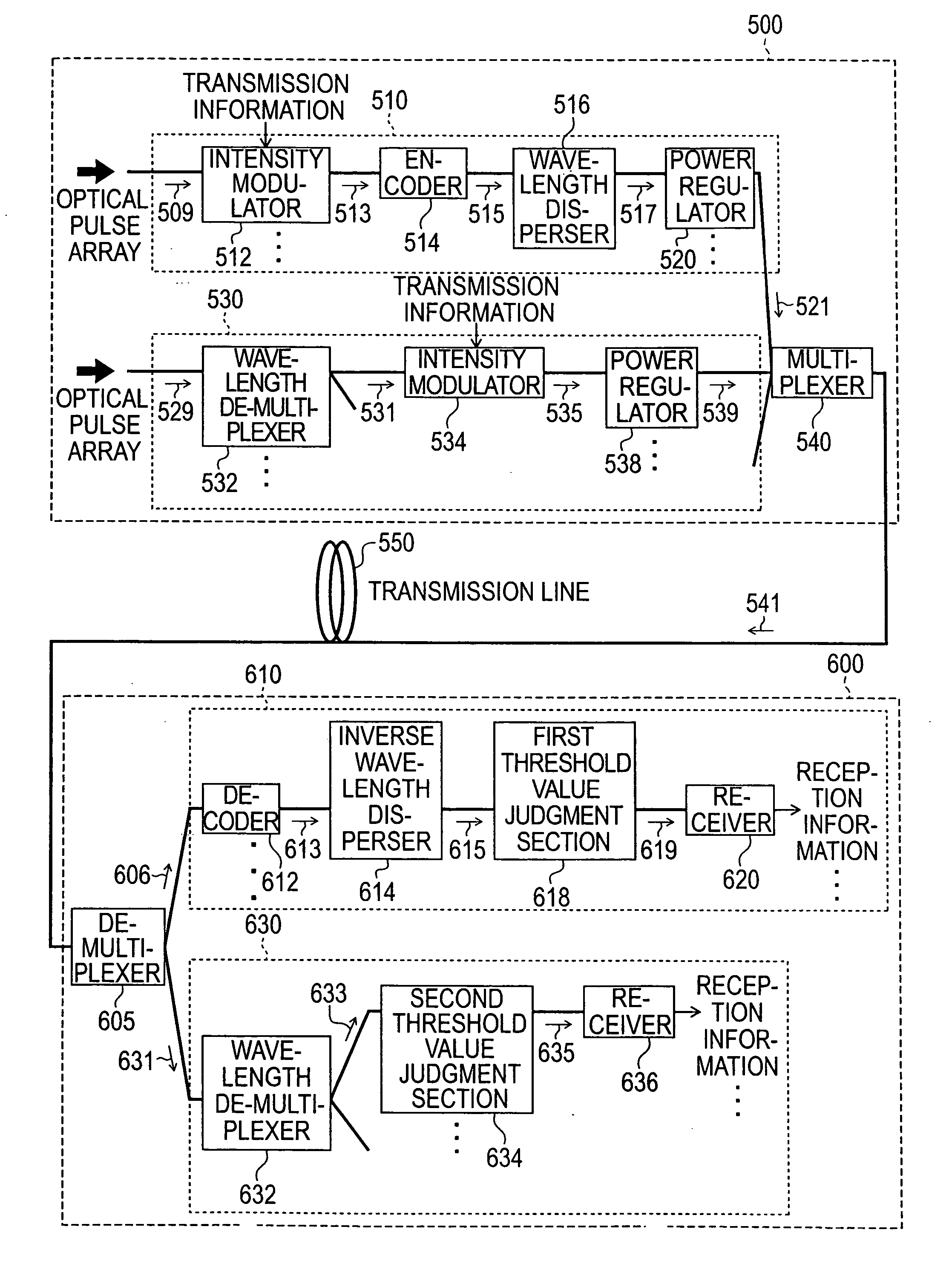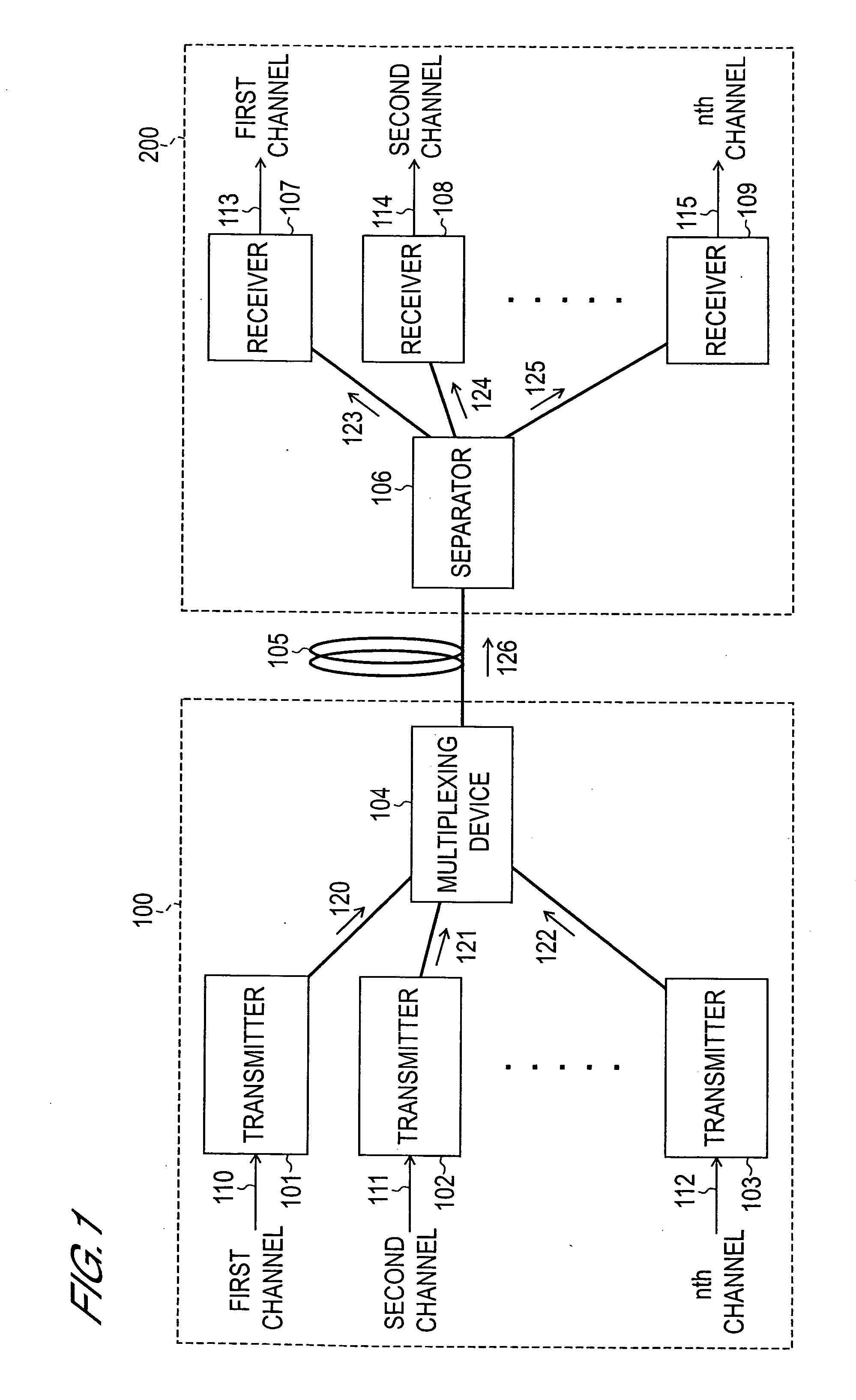[0093] The characteristic of the optical division multiplexing transmission and reception method of the first and second inventions is that the optical code division multiplexing signal generation step included in the transmission step includes a time
waveform shaping step that generates a shaped and encoded optical pulse signal by shaping the time waveform of the encoded optical pulse signal. A further characteristic is that the optical code division multiplexing
signal extraction step included in the reception step comprises a time waveform restoration step that generates a restored encoded optical pulse signal that is similar to the encoded optical pulse signal waveform by restoring the waveform of the shaped and encoded optical pulse signal.
[0094] Hence, the encoded optical pulse signal is transmitted after the time waveform has been shaped by the time
waveform shaping step. In the reception step, the encoded optical pulse signal that has been shaped and transmitted is generated as a restored encoded optical pulse signal that is similar to the encoded optical pulse signal waveform as a result of being restored by the time waveform restoration step.
[0089] On the other hand, with the optical division multiplexing transmission and reception method of the second invention, a shaped and encoded optical pulse signal and an
optical time division multiplexing signal are generated in the transmission step and an optical division multiplexing signal is generated as a result of the shaped and encoded optical pulse signal and
optical time division multiplexing signal being mixed by the multiplexing step. The optical division multiplexing signal is divided into an optical code division multiplexing reception signal and an optical
time division multiplexing reception signal by the branching step that the reception step comprises.
[0096] That is, the optical pulse signal originating in the WDM channel does not undergo the time
waveform shaping step during transmission and, therefore, the optical pulse signal originating in the WDM channel contained in the
optical wavelength division multiplexing reception signal does not undergo time waveform shaping. The optical pulse signal originating in the WDM channel undergoes time waveform shaping at this stage because the time waveform restoration step is executed even when the optical pulse signal does not undergo time waveform shaping. On the other hand, the encoded optical pulse signal is transmitted after the time waveform has been shaped and the shaped time waveform is restored during reception.
[0097] As described hereinabove, in the reception step, even when an optical pulse signal originating in the WDM channel generated in the
optical wavelength division multiplexing signal generation step is mixed in with the encoded optical pulse signal that is transmitted after being shaped, because the time waveform of the optical pulse signal originating in the WDM channel undergoes shaping by the inverse wavelength
disperser that is used in the time waveform restoration step, the optical pulse signal is expanded over the time axis. As a result, the
peak value of the optical pulse signal originating in the WDM channel drops and can be removed by the first threshold value judgment step.
[0098] Likewise, in the optical division multiplexing transmission and reception method of the second invention, a time waveform shaping step is not included in the optical
time division multiplexing signal generation step. As a result, in the reception step, the time waveform of the optical pulse signal originating in the OTDM channel contained in the optical code division multiplexing reception signal is not shaped. The time waveform of the optical pulse signal originating in the OTDM channel is shaped by the inverse wavelength disperser that is used in the time waveform restoration step of the optical code division multiple signal extraction step.
[0099] That is, the optical pulse signal originating in the OTDM channel does not undergo the time waveform shaping step during transmission and, therefore, the optical pulse signal originating in the OTDM channel contained in the received optical code division multiplexing reception signal does not undergo time waveform shaping. The optical pulse signal originating in the OTDM channel undergoes time waveform shaping at this stage because the time waveform restoration step is executed even when the optical pulse signal does not undergo time waveform shaping. On the other hand, the encoded optical pulse signal is transmitted after the time waveform has been shaped and the shaped time waveform is restored during reception.
[0100] As described hereinabove, in the reception step, even when the optical pulse signal originating in the OTDM channel generated in the optical
time division multiplexing signal generation step is mixed in with the encoded optical pulse signal that has been shaped and transmitted, the time waveform of the optical pulse signal originating in the OTDM channel undergoes shaping by the inverse wavelength disperser that is used in the time waveform restoration step and the optical pulse signal is expanded over the time axis. As a result, the
peak value of the optical pulse signal originating in the OTDM channel drops and can be removed by the first threshold value judgment step.
[0101] Therefore, it can be seen that, according to the optical division multiplexing transmission and reception method of the first invention, OCDM communication and WDM communication can be implemented in parallel. Further, it can be seen that, according to the optical division multiplexing transmission and reception method of the second invention, OCDM communication and OTDM communication can be implemented in parallel. Based on this fact, an optical multiplexing transmission and reception device to which an OCDM channel has been added and an optical multiplexing transmission and reception method can be implemented without changing the usage wavelength bandwidth of the existing WDM channel. Further, an optical multiplexing transmission and reception device to which an OCDM channel has been added and an optical multiplexing transmission and reception method can be implemented without changing the time slot allocated to the existing OTDM channel.
[0102] Furthermore, if the
encoder and decoder of the optical division multiplexing transmission and reception device of the first and second inventions are constituted comprising a
Fiber Bragg
grating, the transmission lines of the optical division multiplexing transmission and reception device are constituted by
optical fiber and, therefore, a
Fiber Bragg
grating formed by using optical
fiber has a form that is useful for connection. That is, an
optical circulator, as will be described subsequently, is used to form the
encoder and decoder, and, therefore, a
Fiber Bragg
grating is very useful for the connection with the
optical circulator.
[0104] Further, the first and second threshold value judgment sections of the optical division multiplexing transmission and reception device of the first and second inventions is preferably constituted comprising a light saturable absorber. It is confirmed that the threshold value judgment section that uses a light saturable absorber possesses resistance to light destruction and mechanical destruction as well as
water resistance and has a very long lifespan. Therefore, the threshold value judgment section that uses a light saturable absorber is preferably used in the optical multiplexing transmission and reception device.
 Login to View More
Login to View More  Login to View More
Login to View More 


